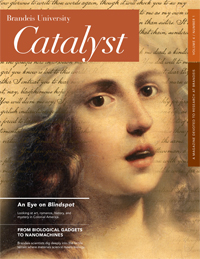See the light in latest Catalyst magazine
Ingrid Schorr explores artist Susan Lichtman's paintings
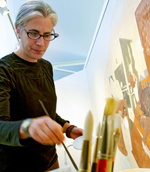
Susan Lichtman
In artist Susan Lichtman's paintings, people seem to embody their entire history of experience, and light captures all the shifting moods of the day.
The first thing you notice about painter Susan Lichtman is her glasses: black frames with asymmetrical curlicues at the temples, in elegant contrast to her warm brown eyes and moon-white hair. Their razor thinness mirrors Lichtman’s acute way of seeing. She constantly frames, reframes, and zooms in to find the detail, the color, and the composition that will transform an ordinary domestic scene into a vibrant canvas full of possibility.
Lichtman, an associate professor of fine arts at Brandeis since 1980 and currently director of the studio art program, is an accomplished painter whose subjects range from Russian literature and politics to real estate and the economy.
|
Download the fall 2009 |
Three decades into an artistic career honored early on by the American Academy and Institute of Arts and Letters, as well as by the Louis Comfort Tiffany Foundation, Lichtman is still drawn to the mystery in painting. She begins by making large drawings in ink, washing large areas of paper and leaving significant areas untouched. These initial ideas become more potent interpretations of her subject when she moves to canvas and employs an intentionally narrow range of colors, “a kind of envelope into which everything is placed,” she explained in a recent interview with American Artist magazine.
The story is in the details
“There’s always the question of whether the painting is finished,” says Lichtman. “You set the stage and the ideas, and shapes and relationships between them are specific, and that’s where you can start manipulating. But something is lost every time you move on. You can’t save the rough draft.”
But by using detail deftly—not for the sake of being intricate or miniature but rather to illuminate the story that the subject tells—she creates a narrative on the canvas as it might exist over time.
“A problem with a certain kind of realistic painting is that everything is in focus, but that’s not the way we see the world. A 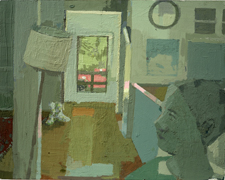 cinematographer can dwell, move, skip over an image,” she continues. “That’s how paintings read through time. I want to make a painting that can be experienced the way you can behold a room over time.”
cinematographer can dwell, move, skip over an image,” she continues. “That’s how paintings read through time. I want to make a painting that can be experienced the way you can behold a room over time.”
This is exactly what occurs in "Front Door," an eight-inch by ten-inch panel implausibly crowded with a tilted lamp, a female figure, and a door open to a splash of outdoor pink. For all its crowdedness, the interior’s lambent greens and blues give the impression of sudden silence, of an emotionally resonant room somehow at odds with the world.
“I was laid up last summer with a broken foot,” explains Lichtman, “and this is what I saw from my couch. People would come by and pick up my kids and return them later in the day.”
Information beneath the surface
“While the surface of Lichtman’s work is clearly made of paint, the underlying structure contains a world of information,” says Mark Brosseau, an artist and curator in Philadelphia. “This is what makes the pieces so provocative—under that surface the figures contain their entire history of experience, and the light seems to embody all the shifting moods of that day. Her use of color is so specific that she is able to communicate all of this with just a single image.”
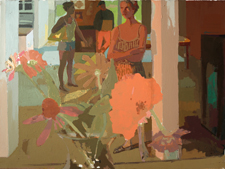 Coming from a family of scientists, Lichtman appreciates the rigor demanded of perceptual painting and perspective drawing. In this regard, she echoes the English Romantic painter John Constable, who believed landscape painting could be considered a branch of the natural sciences. She earned an undergraduate degree in studio art at Brown University, then an MFA at Yale’s renowned School of Art, where she worked with a variety of painters, including the realist William Bailey; Gretna Campbell, known for her plein-air landscapes; and Andrew Forge, who broke from figurative painting in the 1950s in favor of abstraction.
Coming from a family of scientists, Lichtman appreciates the rigor demanded of perceptual painting and perspective drawing. In this regard, she echoes the English Romantic painter John Constable, who believed landscape painting could be considered a branch of the natural sciences. She earned an undergraduate degree in studio art at Brown University, then an MFA at Yale’s renowned School of Art, where she worked with a variety of painters, including the realist William Bailey; Gretna Campbell, known for her plein-air landscapes; and Andrew Forge, who broke from figurative painting in the 1950s in favor of abstraction.
Embracing the everyday moment
Just as in the study of music or theater, or even science or history, every generation must sift through accumulated styles and trends and ways of thinking. Today’s art student faces the unique environment of postmodernism, which promotes new technology and new ideas of ownership and appropriation. While art critics declare the death of painting every few years, enrollment in fundamental fine arts courses at Brandeis continues to grow even as the university adds courses in digital design and video editing.
“Students are not troubled by the ‘death’ of painting,” says Lichtman. “They understand how computers and cameras are no substitute for the hand."
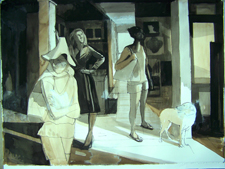 Amid the onslaught of new technologies and ways of communicating through art, Lichtman says, “the everyday moment is being embraced for its poetic potential and even its political implications. I’m seeing young painters savor the details of their apartments, cafés, their clothing, the postures of their friends—all as fodder for visual compositions. Is it because of Frida Kahlo—or Facebook and YouTube?”
Amid the onslaught of new technologies and ways of communicating through art, Lichtman says, “the everyday moment is being embraced for its poetic potential and even its political implications. I’m seeing young painters savor the details of their apartments, cafés, their clothing, the postures of their friends—all as fodder for visual compositions. Is it because of Frida Kahlo—or Facebook and YouTube?”
Or is it because these students are learning from a painter who pulls form and color from the atmosphere? From the air and the light in her Rehoboth, Massachusetts, studio, Lichtman has found a visual language that carries the weight of the mandate she gives her students: to be honest, complex, and persuasive.
Ingrid Schorr is program administrator for the Office of the Arts.

